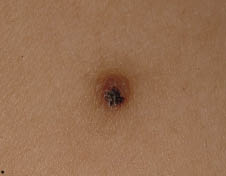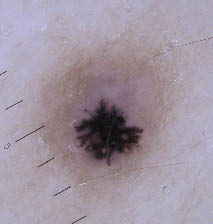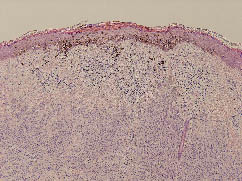Yuichi Yoshida1, Nanako Yamada1, Koji Adachi1, Masaru Tanaka2 and Osamu Yamamoto1
1Division of Dermatology, Department of Medicine of Sensory and Motor Organs, Faculty of Medicine, Tottori University, 86 Nishi-cho, Yonago-shi, Tottori 683-8503, and 2Department of Dermatology, Tokyo Woman’s Medical University Medical Center East, Tokyo, Japan. E-mail: yxy@grape.med.tottori-u.ac.jp
Accepted February 11, 2008.
Sir,
Recurrent melanocytic naevus after incomplete excision or trauma sometimes shows atypical clinical and histological features (1, 2). We describe here a case of melanocytic naevus showing a starburst pattern on dermoscopy after scratching.
CASE REPORT
A 47-year-old Japanese woman presented with a 3-month history of a black spot on a brown nodule. She had noticed a small nodule on her right arm during childhood. She noticed a black spot at the centre of the lesion after scratching, and therefore visited our department for evaluation of the lesion. On physical examination, a 2-mm diameter black spot was observed in the centre of a 4-mm diameter soft nodule, which was relatively uniform in colour (Fig. 1). Dermoscopic examination revealed a typical starburst pattern (black diffuse pigmentation with regular radial streaks at the periphery) situated in the whitish pink scar-like area at the centre and surrounded by a thin light-brown pigment network at the periphery (Fig. 2). The lesion was surgically excised under local anaesthesia. Histopathological examination showed hyperkeratosis and marked proliferation of melanocytes with large amounts of melanin pigments in the epidermal basal layer. Some melanocytes showed mild atypia, but no mitotic figures were found. Abundant melanin granules were distributed up to the horny layer, which seemed to correspond to the dermoscopic feature of starburst pattern. In addition, there was infiltration of lymphocytes and melanophages in the upper dermis with mild-to-moderate fibrosis, and nests of round-shaped naevus cells were observed in the mid-dermis (Fig. 3). Immnunohistochemically, most of the tumour cells were positive for S-100 protein and Melan A, whereas stains for HMB-45 and Ki-67 were negative. Based on these findings, we made a diagnosis of recurrent melanocytic naevus.

Fig. 1. A brown nodule with a central black spot on the right arm of a 47-year-old woman.
Fig. 2. Starburst pattern with black prominent pigment network and streaks surrounded by a diffuse whitish pink scar-like area at the centre and a thin, light-brown pigment network at the periphery (original magnification ×10).
Fig. 3. Proliferation of melanocytes with large amounts of melanin pigments through the epidermis and horny layer and nests of naevus cells in the reticular dermis (haematoxylin and eosin; original magnification ×100).
DISCUSSION
Dermoscopy is now widely used as a useful tool to diagnose pigmented and non-pigmented cutaneous neoplasms (3). A characteristic starburst pattern on dermoscopy is commonly observed in pigmented Spitz naevus (Reed naevus) at the late stage and is a clue for accurate diagnosis (4). This pattern correlates with the histopathological feature of heavily pigmented nests of melanocytes along the dermoepidermal junction (5). Since the black spot in the present case was clinically small and uniform, the lesion was not likely to be atypical. In addition, dermoscopic examination showed a typical starburst pattern, suggesting Spitz naevus. However, histopathological examination revealed melanin pigments distributed both in hyperplastic melanocytes and keratinocytes in the epidermis with nests of naevus cells in the dermis. Therefore, the lesion was considered to be a long-lasting melanocytic naevus with a partial recurrence after minor trauma in a middle-aged woman. Although the exact mechanism of the development of such dermoscopic features in our patient is not clear, it was probably caused by mechanical trauma (scratching) by the patient. It is known that Spitz naevus can also occur in areas of injury (6). Interestingly, it has been reported that recurrent melanocytic naevus following incomplete excision or trauma sometimes shows atypical histological features, described as “pseudomelanoma” (1, 2). Furthermore, it has been demonstrated that fibroblasts influence the activity of melanocytes (7). We speculate that some melanocytes migrated from the dermis to the epidermis by scratching of the lesion. The proliferation of migrated or residual epidermal melanocytes and the stimulation of their melanin production might have been induced in the wound-healing process, resulting in the characteristic melanin pigment distribution (dermoscopic starburst pattern) mimicking pigmented Spitz naevus.
We emphasize that it is important for clinicians to be aware of the dermoscopic pattern of recurrent naevus after injury and differentiate it from melanoma or Spitz naevus in order to avoid misdiagnosis and unnecessary overtreatment. However, we recommend excision of any lesion with a starburst pattern in adulthood in order to rule out the possibility of melanoma.
REFERENCES
1. Botella-Estrade R, Nagore E, Sopena J, Cremades A, Alfaro A, Sanmartin O, et al. Clinical, dermoscopy and histological correlation study of melanocytic pigmentations in excision scars of melanocytic tumours. Br J Dermatol 2006; 154: 478–484.
2. Arpaia N, Cassano N, Antonio-Vena G. Melanocytic nevus with atypical dermoscopic features at the site of radiodermatitis. Dermatol Surg 2006; 32; 100–102.
3. Kittler H, Pehamberger H, Wolff K, Binder M. Diagnostic accuracy of dermoscopy. Lancet Oncol 2002; 3: 159–165.
4. Pizzichetta MA, Argenziano G, Grandi G, de Giacomi C, Trevisan G, Soyer HP. Morphologic changes of a pigmented Spitz nevus assessed by dermoscopy. J Am Acad Dermatol 2002; 47: 137–139.
5. Argenziano G, Scalvenzi M, Staibano S, Brunetti B, Piccolo D, Delfino M, et al. Dermatoscopic pitfalls in differentiating pigmented Spitz naevi from cutaneous melanomas. Br J Dermatol 1999; 141: 788–793.
6. Weimer VM, Zuehlke RL. Multiple agminate spindle and epithelioid cell nevi in an adult. Arch Dermatol 1978; 114: 1383–1384.
7. Hedley SJ, Layton C, Heaton M, Chakrabarty KH, Dawson RA, Gawkrodger DJ, et al. Fibroblasts play a regulatory role in the control of pigmentation in reconstructed human skin from skin types 1 and 2. Pigment cell Res 2002; 15: 49–56.






